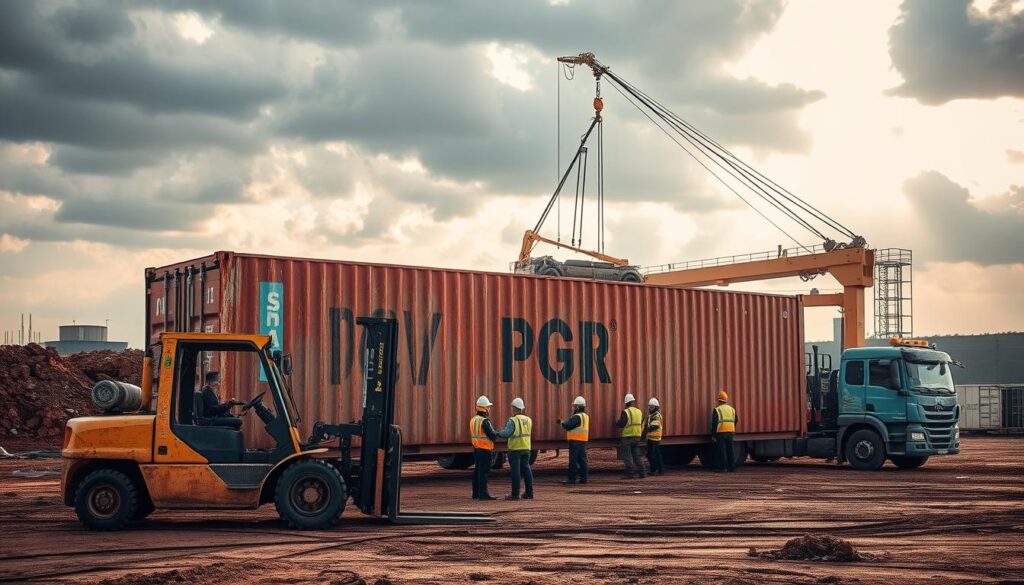Disposing of a shipping container can be a daunting task, especially if you’re unsure of the best disposal methods. Whether you’re looking for ways to sell, donate, recycle, or repurpose your container, it’s essential to explore the available options.
Proper disposal is not only environmentally friendly but also potentially cost-effective. In this guide, we’ll walk you through the various methods for disposing of a shipping container, helping you make an informed decision.
Key Takeaways
- Explore various disposal methods for shipping containers.
- Understand the environmental and financial benefits of proper disposal.
- Learn about selling, donating, recycling, and repurposing options.
- Discover the importance of choosing the right disposal method.
- Make an informed decision based on your needs and preferences.
Understanding Your Shipping Container Disposal Options
Disposing of a shipping container requires a thoughtful approach, starting with understanding your disposal options. The decision on how to get rid of a shipping container depends on several factors, including its condition, age, and material.
Before exploring the available disposal methods, it’s essential to assess the condition of your container. This assessment will help determine the most suitable course of action.
Assessing the Condition of Your Container
The condition of your shipping container plays a significant role in deciding its disposal method. Factors such as damage, rust, and overall structural integrity need to be evaluated.
Factors That Affect Disposal Decisions
Several factors influence the decision on how to dispose of a shipping container. These include the container’s age, material, and any damage it may have sustained. Understanding these factors will help you make an informed decision.
The table below summarizes the key factors that affect disposal decisions and the corresponding disposal methods:
| Container Condition | Age | Material | Disposal Method |
|---|---|---|---|
| Good | Less than 10 years | Steel | Sell or Donate |
| Fair | 10-20 years | Aluminum | Recycle or Repurpose |
| Poor | More than 20 years | Mixed | Recycle |
Overview of Available Disposal Methods
There are several disposal methods available for shipping containers, including selling, donating, recycling, and repurposing. Each method has its advantages and disadvantages, which will be explored in subsequent sections.
Understanding your shipping container disposal options is the first step towards getting rid of your old container efficiently.
Selling Your Shipping Container for Profit
Selling your shipping container can be a profitable venture if you approach it with the right strategy. To maximize your profit, it’s essential to understand the process from determining your container’s value to handling the transaction.
Determining Your Container’s Market Value
The first step in selling your shipping container is to determine its market value. This involves assessing its condition, size, and any additional features it may have, such as refrigeration units or modifications for specific uses. Researching similar containers that have been sold can give you a baseline for pricing. You can check online marketplaces, consult with industry experts, or contact potential buyers to gauge interest and potential offers.
Best Platforms to Sell Used Shipping Containers
Choosing the right platform to sell your shipping container is crucial. Online marketplaces like eBay, Craigslist, and specialized shipping container resale websites can connect you with potential buyers. Social media platforms and local classifieds can also be effective. Consider listing your container on industry-specific forums or websites that cater to shipping and logistics companies.
Tips for Creating an Attractive Listing
To attract potential buyers, your listing needs to be detailed and visually appealing. Include clear, well-lit photos of the container from multiple angles, and provide a detailed description of its condition, features, and any repairs or maintenance done. Be transparent about any damage or wear and tear. Highlighting unique features or recent upgrades can make your container stand out.
Handling the Transaction and Transfer
Once you’ve found a buyer, handling the transaction and transfer efficiently is key. Ensure you have all necessary documentation, such as ownership papers and maintenance records. Clearly outline the terms of the sale, including the price, payment method, and any conditions. Arrange for a secure transfer, either by delivering the container to the buyer or by coordinating pickup.
By following these steps and being prepared, you can successfully sell your shipping container for a profit, turning what might be considered waste into a valuable asset.
Donating Your Shipping Container to Charitable Organizations
If you’re looking for a philanthropic way to get rid of your shipping container, consider donating it to a charitable organization. This approach not only disposes of the container in an environmentally responsible manner but also contributes to the community.
Organizations That Accept Container Donations
Several charitable organizations accept shipping container donations. These include non-profit organizations focused on housing, education, and community development. For instance, organizations that build homes for the needy or create community centers often accept container donations.
Tax Benefits of Container Donation
Donating your shipping container can provide tax benefits. In the United States, you may be eligible for a tax deduction based on the container’s fair market value at the time of donation. It’s essential to consult with a tax professional to understand the specific benefits and documentation required.
| Type of Organization | Potential Use of Container | Tax Benefit Eligibility |
|---|---|---|
| Housing Non-profits | Temporary or permanent housing | Yes |
| Educational Institutions | Classrooms or storage | Yes |
| Community Development Organizations | Community centers or offices | Yes |
Donation Process and Documentation
The donation process typically involves contacting the charitable organization to determine their acceptance criteria and procedures. You’ll need to provide details about the container’s condition, size, and location. Proper documentation, such as a receipt or appraisal, is crucial for tax purposes.
Coordinating Container Transportation
Once the donation is approved, coordinating the transportation of the container is the next step. Some organizations may have the resources to collect the container, while others may require you to deliver it. Discussing logistics in advance is essential to ensure a smooth process.
Recycling Your Shipping Container
When considering methods for getting rid of a shipping container, recycling stands out as a beneficial option. This approach not only aids in waste reduction but also contributes to the conservation of natural resources.
Locating Metal Recycling Facilities
The first step in recycling your shipping container is to find a reputable metal recycling facility in your area. These facilities specialize in processing large metal items like shipping containers. To locate one, you can search online or check with local waste management agencies for recommendations.
The Process of Container Recycling
The recycling process involves several key steps. Initially, the container is inspected for any hazardous materials, which are then removed and disposed of according to environmental regulations. The container is then dismantled, and the metal is processed for recycling. This metal can be used to manufacture new products, reducing the need for virgin materials.
Environmental Advantages of Recycling
Recycling your shipping container has significant environmental benefits. It reduces landfill waste, conserves natural resources by reusing existing materials, and decreases the energy required to produce new metals. This process also lowers greenhouse gas emissions associated with metal production.
Potential Compensation for Recycling
In some cases, you may be able to receive compensation for recycling your shipping container. The amount depends on the container’s condition, size, and the current market price for scrap metal. It’s advisable to contact several recycling facilities to compare their offers.
| Recycling Facility Criteria | Description | Importance Level |
|---|---|---|
| Certification | Ensure the facility is certified by relevant environmental agencies. | High |
| Experience | Check how long the facility has been in operation and their experience with container recycling. | Medium |
| Compensation | Compare the compensation offered by different facilities for your container. | High |
By choosing to recycle your shipping container, you are not only getting rid of it in an environmentally responsible manner but also contributing to a more sustainable future.
How to Get Rid of a Shipping Container Through Repurposing
Getting rid of a shipping container can be achieved by repurposing it into a variety of creative projects. Repurposing not only eliminates the container but also adds value by transforming it into something functional and unique.
Popular Repurposing Projects
Shipping containers can be repurposed into numerous projects, including:
- Homes and offices
- Storage units
- Pop-up shops and restaurants
- Art studios and galleries
- Emergency shelters and disaster relief housing
These projects showcase the versatility of shipping containers and the potential for creative repurposing.
DIY vs. Professional Conversion
When repurposing a shipping container, you have the option to undertake the project yourself or hire professionals. DIY conversions can be cost-effective but require significant time, effort, and expertise. On the other hand, professional conversions ensure high-quality results and compliance with regulations but at a higher upfront cost.
Permits and Regulations for Repurposed Containers
Before starting your repurposing project, it’s crucial to understand the local building codes, zoning laws, and permit requirements. Compliance with these regulations is essential to avoid legal issues and ensure the safety of the structure’s occupants.
Selling a Repurposed Container
If you decide to sell your repurposed shipping container, you can potentially recoup your investment or even make a profit. To successfully sell, focus on highlighting the unique features and benefits of your repurposed container, such as its durability, sustainability, and aesthetic appeal.
By repurposing your shipping container, you’re not only getting rid of it but also contributing to sustainable practices and potentially creating a valuable asset.
Hiring Professional Shipping Container Removal Services
Professional shipping container removal services offer a hassle-free solution for container disposal. If you’re not comfortable dealing with the disposal of your shipping container yourself, hiring professionals can be a convenient and stress-free solution.
Finding Reputable Removal Companies
To find a reputable removal company, start by researching local businesses that specialize in shipping container disposal. Check online reviews, ask for referrals, and verify their licenses and insurance.
What to Expect from Removal Services
Removal services typically handle everything from assessment to disposal. They will evaluate your container’s condition, provide a quote, and then remove the container, ensuring it’s disposed of according to regulations.
Average Costs and Timeframes
The cost of removal services varies based on location, container size, and condition. On average, you can expect to pay between $500 to $2,000.
| Container Size | Average Cost | Timeframe |
|---|---|---|
| 20ft | $500-$1,000 | 3-7 days |
| 40ft | $1,000-$2,000 | 5-14 days |

Questions to Ask Before Hiring
Before hiring a removal service, ask about their experience, disposal methods, and whether they provide any guarantees. It’s also essential to inquire about any additional fees.
By choosing a professional service, you can ensure that your container is disposed of safely and efficiently, saving you time and potential legal issues.
Cost Comparison of Different Disposal Methods
Understanding the financial implications of different shipping container disposal methods is essential for making an informed decision. When deciding how to dispose of your shipping container, cost is a significant factor that can influence your choice.
The various disposal methods, including selling, donating, recycling, and repurposing, each come with their own set of costs and potential returns. It’s crucial to weigh these factors to determine the most cost-effective option for your situation.
Upfront Costs vs. Potential Returns
When evaluating disposal methods, consider both the upfront costs and the potential returns. For instance, selling a shipping container can yield a significant return, but it may require initial investments in advertising and inspections to attract buyers. On the other hand, donating a container can provide tax benefits, but the return may not be as direct or immediate.
Selling a shipping container can be profitable if the container is in good condition. The return on investment can be substantial, but it’s essential to factor in the costs of marketing and potential repairs to make the container saleable.
Hidden Expenses to Consider
Beyond the obvious costs, there are hidden expenses to consider when disposing of a shipping container. For example, if you’re recycling a container, you might need to pay for dismantling or preparation before it can be accepted by a recycling facility.
- Transportation costs to the recycling facility or buyer’s location
- Potential repair costs to make the container saleable
- Inspection fees to assess the container’s condition
Most Cost-Effective Options by Container Condition
The condition of your shipping container plays a significant role in determining the most cost-effective disposal method. Containers in good condition can be sold or repurposed, potentially yielding a higher return. Conversely, damaged or unusable containers might be more suited to recycling.
Long-Term Financial Considerations
When choosing a disposal method, it’s also important to consider the long-term financial implications. For example, repurposing a container can provide long-term value through its continued use, whether for storage or as a converted living space.
By carefully evaluating the costs associated with each disposal method and considering the condition of your shipping container, you can make an informed decision that aligns with your financial goals.
Preparing Your Shipping Container for Removal
Preparing your shipping container for removal involves several critical steps. Ensuring that your container is properly prepared can make the removal process smoother and less complicated.
Cleaning and Emptying the Container
The first step in preparing your shipping container is to clean and empty it. Remove any debris, cargo, or unwanted materials from the container. This not only makes the container lighter and easier to handle but also ensures that you’re not inadvertently disposing of valuable items or hazardous materials.
Addressing Potential Hazardous Materials
If your container has held hazardous materials, it’s crucial to address this issue. Check if there are any residual chemicals or substances that need special handling. Dispose of these materials according to local regulations and guidelines to avoid any environmental or health risks.

Site Preparation for Container Removal
Ensure the site where the container is located is accessible for removal equipment. Clear any obstacles or barriers that could hinder the removal process. This includes trimming vegetation, removing other containers or objects, and ensuring the ground is stable enough for heavy machinery.
Logistics of Container Transportation
Finally, plan the logistics of transporting the container. Decide on the transportation method, whether it’s by road, rail, or sea, and ensure you have the necessary permits and equipment. Coordinating with a professional removal service can simplify this process.
Conclusion
Getting rid of a shipping container can be a daunting task, but with the right guidance, it can be a straightforward process. Whether you decide to sell, donate, recycle, or repurpose your container, it’s essential to choose a method that aligns with your financial situation, environmental values, and personal preferences.
By considering the options outlined in this article, you’ll be well-equipped to make an informed decision and ensure that your shipping container is disposed of in a responsible and beneficial manner. Effective shipping container removal not only helps in decluttering your space but also contributes to environmental sustainability.
When getting rid of an old shipping container, it’s crucial to prepare it properly for removal, whether you’re handling it yourself or hiring professionals. This includes cleaning, addressing potential hazardous materials, and coordinating logistics. By doing so, you’ll ensure a smooth and efficient process.

